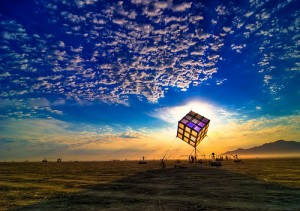Burning Man, Technology & Time: A Sociological Look at Scheduling
August 24, 2011You may imagine that people who make the annual desert pilgrimage to Burning Man do so to escape their schedules and technology. That there, hundreds of miles from a dot on the map, in dust so alkaline it will eat your iPhone, people must put aside devices of connectivity; they must rediscover other ways of connecting. The reality is far more paradoxical. Burning Man is simultaneously the last vestige of an unplugged tribal culture and a frontier-edge of adoption. This year, the introduction of several new tools—including an iPhone app and a social media technology—highlights a profound but basic principle: how radical the introduction of a technology occurs is a function of the society into which that technology is introduced.
Think of time-keeping, one of our most ancient technologies. Like the smartphone, its purpose is to enable connectivity. By providing a baseline for synchronization, time-keeping devices allow us to schedule meetings, dates, and appointments. There’s hardly a society on the planet that could claim to be unhinged from the clock. Most of us see the time whenever we look at our cell phone or computer.
According to recent market research studies, cells phones and computers have largely supplanted wristwatches as users’ primary time-keeping devices. There is rarely cell service at Burning Man, so most participants leave their phones in the car. Those with all but the greatest love of horology go watch-less, and dinner dates are timed by the setting of the sun.
This year, the 1MileClockProject will broadcast the time using three high-powered lasers directed at twelve 22’ clock towers positioned around the city. It’s Burning Man’s first central time-keeping device. This installation doesn’t parallel the ubiquity of time-keeping mobile devices in the real world, but it does provide a publicly available baseline for synchronization. It has the potential to create radical shift in the Burning Man experience. Will people synchronize to this clock? Will it diminish their experience of synchronicity? It will invoke reaction. How radical the introduction of a technology occurs is a function of the society into which that technology is introduced. In a society that has been timeless, the introduction of a very old technology may be revolutionary.
Other technologies new to the festival this year also relate to schedule-keeping and connectivity. The first, a free iPhone app called “Time to Burn,” provides the event directory in searchable format. A calendar icon next to each entry allows the user to automatically add the event and a reminder alarm to their iPhone calendar. Should they choose to lug their device through the dust, they’ll get a friendly nagging “ding!” when it’s time to meet their friend at the next party. Will people use this app as a tool to see more of what they want in Black Rock City? Or will they view it as an invasive reminder of their otherwise overscheduled world?
Most scheduling consists of two agreed-upon components: place and time. Now that the 1MileClockProject can provide you the time, all that’s needed is a meeting place. Thanks to BurnerMap, you can have a personalized map of where all your friends are camping. The Facebook plug-in asks users to locate themselves on Burning Man’s grid—which, ironically, has always been laid out radially like a clock face—then it aggregates shared information from the user’s Facebook contacts. Now that chance playa meeting can become a certainty. Provided, of course, your calendar is clear.
Scheduling and social media technologies are commonplace in the real world. At Burning Man, they operate in a new context. What is unremarkable in one venue becomes astonishing in another. At Burning Man, where everything from costumes to culture is created with a sense of stewardship, reactions are amplified. The drama of our evolving relationship to technology is highlighted. Who will be a bastion of resistance, and who will embrace change?
(The Octa teams leaves for Burning Man in five days. If we have connectivity, look for updates from the playa!)







The Octa team has returned! We DID have intermittent iPhone service, and I saw many people taking photos with their iPhones. I did not see any iPads, save in the RV on the drive out and back, in the hands of Octa team members themselves. The clock, while it shot giant lasers across the sky, did not provide a reliable means for time-tracking. However, many people commented that it was the most “on schedule” burn they had ever attended. Perhaps that is due to the lack of dust storms…
Fairly! This was a very fantastic publish. Thanks for the offered data.
In creating the 1MileClock we decided in the end to make all three hands of the clock using only green lasers instead of red/blue/green as originally intended. We felt that the Clock should be “interpreted” and not IN YOUR FACE and “easy” to figure out. This way, participants that adhered to the “playa time” concept, did not have to have REAL time ticking past them every 60 seconds…
I do hope you enjoyed our art! – Jim Bowers – Artist – 1MileClock Project.
Thanks for this added information, Jim! We definitely appreciated your art, as well as your decision to create an interpretive, rather than an “in your face”, experience. Playa time sure flew this year!
Wondering what the theme is for Burning Man 2012!